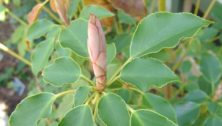Tu BiShvat, Jewish ‘New Year of the Trees,’ Recalls a Concentration Camp Sapling Saved in New Hope

Tu BiShvat, today’s Jewish “New Year of the Trees,” features a number of ecologically oriented celebrations. But it also recalls a significant silver maple tree steeped with meaning. Sasha Rogelberg covered the historic sapling for the Jewish Exponent.
The tree is known as “The Theresienstadt Tree,” named for a concentration camp located in what is now the Czech Republic.
According to the Holocaust Awareness Museum and Education Center blog, the tree may have been smuggled onsite and planted by a volunteer teacher to mark Tu BiShvat 1943.
It became a sign of hope, as the children of the camp cultivated it by sacrificing portions of their rationed drinking water to keep it healthy.
The tree survived into the 1990s. While it stood, visitors collected seeds and saplings and replanted them worldwide.
One sapling — with ten third-generation offspring from it — was cultivated at the New Hope farm of Jewish Federation of Greater Philadelphia’s retired President Bud Newman.
The tree’s lineage now includes plantings at the Horwitz-Wasserman Holocaust Memorial Plaza in Philadelphia and the Museum of Jewish Heritage in New York.
“I look at these trees as being symbolic of more people recognizing what Jews have gone through, and more people recognizing that Jews are survivors, and their strengths and their attitude towards continuing through survival is miraculous,” said Newman.
Read more about the tree in the Jewish Exponent.
Connect With Your Community
Subscribe for stories that matter!
"*" indicates required fields





























